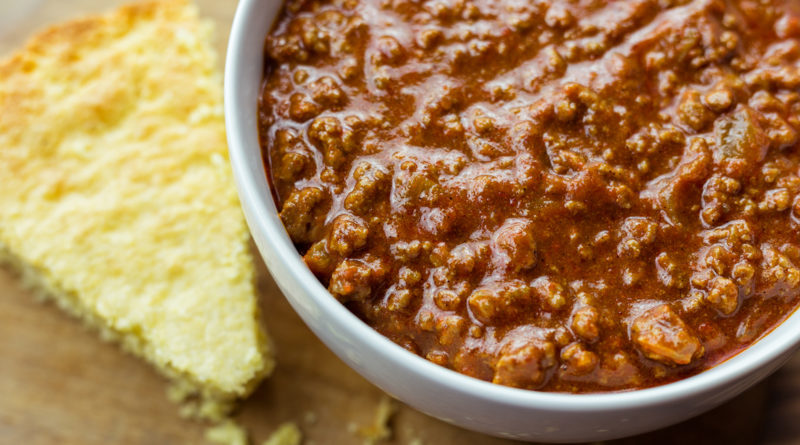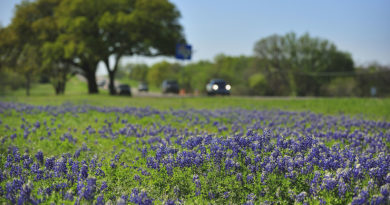Beans are for Yankees When It Comes to Texas Chili
By Janna Zepp
During this time of year, Texans thoughts turn to chili.
Actually, chili is always on the minds of Texans regardless of the temperature. It is, after all, the official dish of Texas.
Surprised? What? Did you think it was barbecue? Tex-Mex? No way. It’s chili, hands down. Will Rogers called chili a “bowl of blessedness” which gets him forgiven for being born in Oklahoma. True Texans know that chili is NOT made with beans.
Beans, my friend, are for Yankees. That little nugget of truth was even sung about by Ken Finlay in his song “If You Know Beans About Chili, You Know That Chili Has No Beans.”
“You burn some mesquite and when the coals get hot, you bunk up some meat and you throw it on a pot.
“While some chile pods and garlic and comino and stuff, then you add a little salt till there’s just enough.
“You can throw in some onions to make it smell good.
“You can even add tomatoes, if you feel like you should.
“But if you know beans about chili, you know that chili has no beans.
“If you know beans about chili, you know it didn’t come from Mexico.
“Chili was God’s gift to Texas, or maybe it came from down below.
“And chili doesn’t go with macaroni, and damned Yankees don’t go with chili queens; and if you know beans about chili, you know that chili has no beans.”
Chili and Texas are one. They are inseparable. But not all chili is from Texas.
Ohio, it seems, is also home to a kind of chili.
Years ago, I was in Cincinnati shooting with the fire department for a training video company for which I worked at the time. The firefighters knew I was not just from Texas; I was a sixth-generation Texan. So they wanted to take me out for true chili. We went to Skyline Chili, and I made the mistake of complimenting them on their fine spaghetti sauce. Then I asked when I got to sample the chili.
Oops.
I was roundly and soundly educated on the difference between Texas chili and Cincinnati chili.
In my recent chili research, I learned from whatscookingamerica.net that Cincinnati chili was created by a Macedonian immigrant, Tom Kiradjieff. He started a Greek restaurant there in 1922, but no one knew anything about Greek food back then. So he created a kind of “chili” made with Greek spices. His creation included spaghetti, chopped onion, red kidney beans and shredded yellow cheese. He served it with oyster crackers and a side of hot dogs served with more shredded cheese.
It’s fine stuff, but I doubt it’s ever had a song written about it. If you know differently, please let me know.
Let’s get back to Texas chili.
The red stuff is so revered by Texans that there are a multitude of chili cook-offs year-round in Texas. I’ve even been a part of a chili cook-off team. We made what we called Cow Chip Chili. I can’t repeat our slogan. It’s disgusting. But the chili was five-star excellent. To this day, I only know part of the recipe. We all only had parts. Only our team captain knew all the ingredients. And, no, I won’t reveal even my miniscule part. That would violate the Texas Chili Code of Ethics.
Chili cook-off teams are part culinary genius and rabid silliness. Teams are judged on the quality of the product and the craziness of costumes, presentation and on theatrical sketches that border on bad Vaudeville routines. The Cow Chip Chili team was made up of otherwise “normal” people who dressed up as cowboys (and one cowgirl, thank you very much) and engaged in gunfights about six times a day throughout the event.
I knew of one team out of Houston that had a contact at NASA. Their chili cooker was sided with tiles from the Space Shuttle for insulation.
Yes. Really.
That just goes to show that in Texas, chili is serious business.
The granddaddy of all chili cook-offs is The Original Terlingua Championship Chili Cookoff (terlinguachilicookoff.org/).
The first cook-off in 1967, created and promoted by Frank X. Tolbert and friends, only had two cooks, New Yorker, H. Allen Smith, and Texas legend Wick Fowler. It was supposed to settle the dispute over who knew more about chili — Texans or New Yorkers. I am horrified to report that the contest ended in a draw.
That two-man publicity stunt has more than 50 years of history now, and has grown into an event drawing thousands of attendees to Terlingua the first Saturday in November every year, and the days leading up to Saturday, to help celebrate and carry on the tradition. Each Chili Season Year, chili cooks participate in their local area sanctioned events, earning points toward qualification. Points needed vary by state, depending mostly on population. In Texas, the required number is nine.
So while Tex-Mex cooking and barbecue certainly are staples of the Texas diet, no other dish holds the same almost religion-status as does Texas chili.
I once asked my father, a Texan’s Texan, what sealed the deal for him proposing to my mother. After reciting the long list of reasons he loved her, he paused reverently and whispered, “Her chili was better than my mother’s.”
Janna Zepp’s Texas Chili
1 pound ground beef, 1 pound pork sausage browned together
1 tablespoon olive oil
2 medium onions, chopped (one for cooking, one for garnish)
4 cloves garlic, minced
3/4 teaspoon salt
1 teaspoon ground black pepper
1 chopped green bell pepper
1 chopped red bell pepper
1 tablespoon chili powder
2 teaspoons garlic powder
1 teaspoon pepper sauce
1 regular can diced tomatoes
1 regular can tomato sauce
1 tablespoon ground cumin
1 tablespoon Worcestershire sauce
2 tablespoons lemon juice
1 regular can cream of mushroom soup
1 regular can cream of chicken soup
1 12 oz. can of beer (optional)
Top with sour cream, shredded cheese and diced onions. The sour cream cuts the spice a bit so it doesn’t singe delicate palettes.
Brown ground beef and sausage together in olive oil with onion, garlic, salt and pepper in a large pot. Break up meat with spatula as you cook. Drain off fat. Add bell peppers, chili powder, garlic powder and hot pepper sauce. Continue to cook on low heat for 3 minutes while stirring. After 3 minutes, add the remaining ingredients and gently bring to a boil. Allow it to simmer for 15 minutes then turn off heat and allow it to cool to an edible level before serving.




